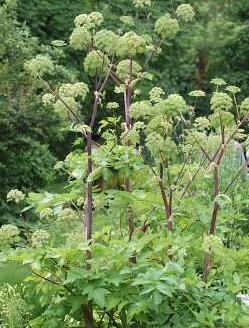New Account | Seed Mix |
Gift Certificates |AAS Winners |
Gardening Products
SEEDS: Unusual | Annuals | Perennials | Vegetables | Herbs | Trees
Angelica Seeds
Useful gardening information
Angelica (Angelica archangelica) is a lovely, brilliant green herb that grows about 3-8 feet tall if planted in the ground. It is a biennial, as it normally dies after flowering in its second year. Easily grown in zones 4-9.Young succulent stems and leaves can be eaten in salads, roasted or made into tea. They are also used for making candied angelica. Angelica seeds can be used for flavoring.
Angelica is used extensively in herbal medicine. The main constituents of Angelica are volatile oils, valeric acid, angelic acid, angelicin, safrole, scopoletin, and linoleic acid, making it useful in the treatment of fevers, colds, coughs, flatulent colic and other stomach disorders.
A medicinal infusion made from stems, seeds, and root is carminative, diaphoretic, emmenagogue, sedative, stomachic and tonic.
Angelica is a very good tonic herb for women and children, the elderly or general debility, it is said to strengthen the heart. Powdered root is said to cause disgust for liquor. It has an antibacterial action, preventing the growth of various bacteria.
Angelica root contains vitamin B12, Zinc, Thiamin, Sucrose, Riboflavin, Potassium, Magnesium, Iron, Fructose, Glucose, and many other trace minerals. Externally it is used as a medicinal gargle for sore throats and mouths and as a medicinal poultice for broken bones, swellings, itching and rheumatism.
An infusion of Angelica root, used as a wash for the face, is said to prevent acne. A powder made from the dried root is used for athlete's foot, as well as an insecticide and pesticide.
Starting seeds:
Sprinkle the seeds into a seed-raising tray filled with seed-raising mix. Cover the seeds minimally. Keep moist across the entire tray. Wait for the seeds to germinate. This will take around 3-4 weeks but this varies.
If you see no signs after 4 weeks, assume the seeds did not take and try with a new batch.
How to make candied stems.

HR301 Angelica ( Angelica archangelica )
Angelica is a biennial plant often grown as an annual. Flowers
have a sweet honey smell. Angelica is a large, rangy plant of northern Europe, that has fresh, pine and citrus notes. It is very attractive biennial that makes a good focal point in the garden.
Angelica will grow to a height of 4-6 ft. and prefers partial shade and a moist, slightly acidic soil.
Angelica is a favorite flavoring herb in Western culinary art. Angelica jams and jellies are very popular. Leaf stalk are employed in confectionary.
All parts of the angelica plant are strongly aromatic and edible. The entire angelica herbs is useful.
The seeds, and the oil from seeds and roots, contribute to the complex tastes of various cordials and digestive liqueurs.
Angelica candied stems were a popular delicacy from medieval times though the 19th century, but they're seldom seen
in the kitchen nowadays. The young leaves can be chopped to add taste to salads, fish dishes and cottage cheese. Fresh stalks can be added to milk puddings, custard and stewed fruits.
Young leaves and shoots are used commercially to flavor alcoholic beverages. Angelica root is the main flavoring ingredient of gin, vermouth Benedictine and Chartreuse.
Angelica will grow to a height of 4-6 ft. and prefers partial shade and a moist, slightly acidic soil.
Angelica is a favorite flavoring herb in Western culinary art. Angelica jams and jellies are very popular. Leaf stalk are employed in confectionary.
All parts of the angelica plant are strongly aromatic and edible. The entire angelica herbs is useful.
The seeds, and the oil from seeds and roots, contribute to the complex tastes of various cordials and digestive liqueurs.
Angelica candied stems were a popular delicacy from medieval times though the 19th century, but they're seldom seen
in the kitchen nowadays. The young leaves can be chopped to add taste to salads, fish dishes and cottage cheese. Fresh stalks can be added to milk puddings, custard and stewed fruits.
Young leaves and shoots are used commercially to flavor alcoholic beverages. Angelica root is the main flavoring ingredient of gin, vermouth Benedictine and Chartreuse.
Share a growing tip or recipe and help other gardeners!

